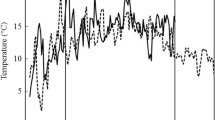Abstract
In the G2 line of peas (Pisum sativum L.), senescence of the shoot apex (which precedes leaf senescence) only occurs in long days (LD) though flowering is independent of photoperiod. It has been suggested that the photoperiodic control of senescence in G2 is mediated through different rates of seed growth. In LD seed growth is more rapid than in short days (SD) and this places a greater nutrient drain on the plant. In addition, more flowers develop into fruits in LD than in SD: 32% of flower buds abort in SD while almost none abort in LD. Senescence is associated with early seed growth and does not occur in deflowered or deseeded plants. Seed development is completed in 30d in LD while it takes 40d in SD, though the seed weights are similar. The maximum rate of fresh-weight gain of all the growing seeds of eight fruits on a plant in SD (1,440 mg/d) does not reach the maximum rate of weight gain of a similar fruit complement in LD (1,720 mg/d). The appearance of senescence symptoms in the shoot apices of LD-grown G2 plants occurs, however, prior to the time of the greatest rate of seed-weight gain. In LD, four fruits with a combined maximum growth rate of 1,250 mg/d are sufficient to cause the appearance of senescence symptoms. This is a lower combined seed growth rate than in SD where senescence does not occur. The seeds in up to 12 fruits can be growing at any time in SD with a combined maximum seed-growth rate (1,660 mg/d), only slightly less than the maximum in LD, with no sign of senescence. It is concluded that the different rates of seed growth occasioned by different photoperiods bear no relation to senescence. However, photoperiod does alter the spatial relationship of the shoot apex and the filling fruits. In LD apical growth becomes slower as fruiting proceeds so that the distance between the filling fruits and the apex is decreased to only two nodes while in SD, because of the delayed fruit development compared to LD, the spatial separation between the fruits and the shoot apex is nine nodes. Even if the growth rate of the plant had remained constant in LD it is calculated that an equivalent fruit complement would still be located three nodes further from the apex in SD than in LD. This increased spatial separation of fruits and apex in SD compared to LD probably alters the source/sink distribution of photosynthate and leaf derived hormones so that larger amounts are available to the apex in SD than LD. Also any “senescence factor” exported from fruits is less likely to reach the apex in SD. In continuously deflorated plants of G2 the two uppermost expanded stipules enclose the apex in SD while in LD they open out. The effect is reversible. Thus photoperiod probably affects the apex and its growth, directly, i.e. independent of fruit development, and this is accentuated by the differing spatial relationships of the apex and fruits resulting from different fruit growth rates under the different photoperiodic conditions.
Similar content being viewed by others
Abbreviations
- LD:
-
long day(s)
- SD:
-
short day(s)
References
Davies, P.J., Proebsting, W.M., Gianfagna, T.J. (1977) Hormonal relationships in whole plant senescence. In: Plant Growth Regulation, pp. 273–280, Pilet, P.E., ed. Springer, Berlin Heidelberg New York
Ingram, T.J., Browning, G. (1979) Influence of photoperiod on seed development in the genetic line of peas G2 and its relation to changes in endogenous gibberellins measured by combined gas chromatography-mass spectrometry. Planta 146, 423–432
Marx, G.A. (1968) Influence of genotype and environment on senescence in peas, Pisum sativum L. Bio Science 18, 505–506
Murfet, I.C. (1977a) Environmental interaction and the genetics of flowering. Annu. Rev. Plant Physiol. 17, 253–278
Murfet, I.C. (1977b) The physiological genetics of flowering. In: The physiology of the garden pea, pp. 385–430, Sutcliffe, J.F., Pate, J.S., eds. Academic Press, London
Murfet, I.C. (1978) The flowering genes Lf, E, Sn and Hr in Pisum: their relationship with other genes, and their descriptions and type lines. Pisum Newsletter 10, 48–52
Noodén, L.D., Leopold, A.C. (1978) Phytohormones and the endogenous regulation of senescence and abscission. In: Phytohormones and related compounds — A comprehensive treatise, vol. II, pp. 329–369, Letham, D.S., Goodwin, P.B., Higgins, T.J.V., eds. Elsevier/North-Holland Biomedical Press, Amsterdam
Pate, J.S., Flinn A.M. (1977) Fruit and seed development. In: The physiology of the garden pea, pp. 431–468, Sutcliffe, J.F., Pate, J.S., eds. Academic Press, London
Proebsting, W.M., Davies, P.J., Marx, G.A. (1976) Photoperiodic control of apical senescence in a gentic line of peas. Plant. Physiol. 58, 800–802
Proebsting, W.M., Davies, P.J., Marx, G.A. (1978) Photoperiod-induced changes in gibberellin metabolism in relation to apical growth and senescence in genetic lines of peas (Pisum sativum L.). Planta 141, 231–238
Reid, J.B. (1979) Far-red reversibility of flower development and apical senescence in Pisum. Z. Pflanzenphysiol. 93, 297–301
Reid, J.B. (1980) Apical senescence in Pisum: a direct or indirect role for the flowering genes. Ann. Bot. 45, 195–201
Sinclair, T.R., de Wit, C.T. (1975) Photosynthate and nitrogen requirements for seed production by various crops. Science 189, 565–567
Author information
Authors and Affiliations
Rights and permissions
About this article
Cite this article
Gianfagna, T.J., Davies, P.J. The relationship between fruit growth and apical senescence in the G2 line of peas. Planta 152, 356–364 (1981). https://doi.org/10.1007/BF00388262
Received:
Accepted:
Issue Date:
DOI: https://doi.org/10.1007/BF00388262




